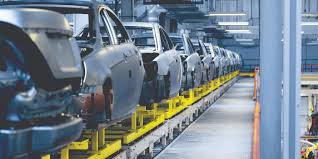
THE automotive sector in Japan is one of the most prominent and largest industries in the world and for the past 10 years their production for new cars has been averaging eight million units every year.
Currently Japan is number three in the world after USA doing 10 million and China doing 30 million cars each year.
It is home to Toyota, Lexus, Mazda, Nissan, Honda, Subaru, Mitsubishi, Isuzu and Hino to mention a few.
The production of reliable and innovative cars has been part of the corner stone of its success, but the amazing corresponding success on the export of used cars to more than 200 countries across the world is the secret that we want to explore this week.
The global market for used cars is familiar with the main compelling reasons why they are attracted to the Japanese cars that includes reliability, excellent condition, low mileage and reasonable pricing compared to other used vehicle supplying countries.
Over the last five years Japan, in accordance with the export data, has been exporting on average about 1.3 million cars every year to Africa, Asia, Europe, North and South America. Japan has a population of 123 million people with a car population of 82 million cars.
So we shall immediately engage the overdrive gear to share the finer details; Majority of Japanese people buy brand new vehicles manufactured within its country.
Over time the comfort of driving brand new cars created a culture of changing cars more often (every five years) than average which became the feeder to the supply of used cars that find their way to the more than 200 countries through export.
- 28K landmines cleared since March
- Motoring: The legendary Toyota Land Cruiser 100 series
- Buyout fund JIP submits $15 bln Toshiba bid without bank backing, Nikkei says
- Croatia beat Japan on penalties to reach quarters
Keep Reading
In majority of cases car manufacturers do some modifications or introduce a new model after every 5 years and accept trade-ins in exchange for the brand new units.
However, having the supply is one thing and it is not equal to compel the markets to buy the used cars.
Japan public transport system
Japan's public transportation system is known for being efficient, reliable, and punctual, making it a popular choice for both locals and tourists.
The main mode of public transport in Japan is the railway system, which is used for high-speed and mass transportation between major cities, as well as commuter transportation in metropolitan areas.
Their efficiency is so strict to the point that when it arrives by one or two minutes late they will make a public apology.
These Japanese trains are among the fastest in the world including the famous Shinkasen, which stands for Japanese bullet train.
I have used the train myself three times during my business trips to Japan and l can attest to what l am writing about.
My research points to the fact that on average 65% percent of the Japanese population uses public and private railway transportation to go to work and other places while the rest uses their cars or cycling and walking.
It is, therefore, from this situation that their personal cars are not usually used during the week days. Majority of Japanese people use their private cars during the weekends when moving around with family.
So for starters this is the main reason why their cars do not accumulate high mileage like what happens in South Africa, Thailand and UK cars.
Perhaps it has never been clear to the market buying these used cars why it is realistic to find a car that is 10 years or 15 years old having low mileage like 30,000kms and still looking clean as new.
Japan vehicle inspection system
Japan has a strict automobile inspection system, called "Shaken", so every three years after a new car is purchased, it must pass the test, which ensures the car is well maintained.
After that, the car must pass the test every two years, and then every year after it turns 10. Vehicles that don't pass the inspection can't be driven on public roads in Japan.
These governments rule force all Japanese to keep their cars in good condition by following the regulation religiously.
Obviously this rule ensures safety to its people by making sure that every car being driven is in good condition to be on the roads and this benefit the buyers on these used cars when exported.
Good roads
Japanese roads are smooth and well-paved, and this results in the cars being less stressed from damage while moving.
This is a very critical aspect that ensures that cars remain in good condition similar to South African cars but unlike many other African countries.
Furthermore, the Japanese culture emphasizes taking good care of cars in which the owner personally takes time to clean their own cars.
Their car culture features vibrant car meets and shows where enthusiasts can display their vehicles and learn from each other.
So it is very common for Japanese car owners to drive their cars for over 15 years without major issues because maintenance is relatively inexpensive, and parts are readily available.
Naturally Japanese are obedient to rules so when the manufacturer or the dealer says that a service should be done on the car, you can bet the typical car owner will do it, no questions asked.
I have been working with Japanese people for the last 10 years and these things l am sharing are true based on experience.
I will share one typical example of how they are disciplined about doings things in an unusual way.
In Japan a fast foods take-away like KFC is manned by a maximum of four staff only. So when you enter the restaurant you join a queue to buy your food and get a receipt.
There a display monitor that shows that your food is ready and you go and collect it by yourself – there are no waiters.
After eating everyone throws away their waste into the bin – YES – literally everyone.
So there is nothing to clean after people finish eating.
A second example is how the Japanese fans who attended the 2022 Qatar World Cup match made headlines off the pitch after staying behind and cleaned the stadium after the match.
This is part of their culture and hence you can imagine what they can do to their own cars! They keep them properly clean which is the reason you receive them in that condition.
Cleaning up after oneself is a time-honored tradition in Japan. From a young age, Japanese people are taught the importance of cleanliness and tidiness and they maintain that in their adulthood.
Competitive car prices
The Japanese used cars are very competitive in price across the world. So in Japan the main used vehicle trading system are the auctions that sell cars on daily basis.
There are more than 150 auctions that auction cars and majority of the Japanese people take their there when they want to sell.
The pricing at the auctions are determined by demand and supply market forces which then control the pricing and benefit the markets that import them.
Majority of the Japanese brand new vehicle dealerships close their financial year every end of March.
So these dealerships have sales targets to meet and they usually offer discounts towards February to sell their stocks before end of March.
This scenario usually causes an oversupply of used cars through trade-ins and results in dropping prices significantly.
It is unlike in other countries such as South Africa, UK or Dubai where the auctions only handle a small portion of the used cars while the majority of cars are sold through the dealerships with marked prices.
Infrastructure for vehicle exports
Furthermore, Japan has the infrastructure for export of vehicles. This infrastructure includes the ports, roll-on/roll-off (RoRo) ships/carriers, containers ships/carriers, automated vehicle auctions and the vanning and devanning expertise and facilities.
The infrastructure is critical in preparing shipping for the cars that would have been purchased by customers in a professional, efficient and consistent manner.
Effective systems on handling used vehicle sales
All cars exported from Japan are categorized by grade as below;
S – Defines brand new or almost new cars – The registration date will not be more than 1 year, speedometer shows less than 10 000 km or more often smaller.
6 – Almost new cars, where the registration date is up to 3 years. Mileage varies till 30 000 km, generally till 10 000 km. On some auction pages, you may found a few almost invisible scratches.
5 – Excellent condition cars - Speedometer shows up to 50 000 km. On the body there may be a few small scratches or dents.
4.5 – Good condition cars. Speedometer shows mileage up to 100 000 km. Also, may be some scratches or dents and a few cases of repair marks on the body.
4 – Accident Free cars. Speedometer could show up to 150 000 km. Some cars may have visible scratches, in the interior you may find tone areas, cigarette holes or stains.
3.5 – Define cars where you may find some with noticeable scratches, dents, rust or corrosion (rare). Inside the vehicle often appear tears, cigarette holes, stains.
3 – Indicate cars with visible huge scratches, dents, paint stains, rust and corrosion. Interior full of tears, cigarette holes or food stains.
2 – Usually means terrible condition cars with rust and corrosion with potential to have all kinds of faults.
1 – Defines cars which got flooded with water before.
RA – Cars which have been fixed after an ordinary car crash.
R – Defines vehicles from a serious previous car crash. This car may be repaired but probably need more fixing. Note that this car may be Immovable.
*** (99, x, etc.) – This vehicle has been in an accident or has some serious engine trouble and was not fixed.
This grading system indeed helps customers improve their understanding of the condition of the cars as much as possible even when they are far away.
However, l must hasten to point out one fact regarding the expectation of many customers.
In as much as l have clarified that some cars can genuinely have low mileage but that cannot apply to pickups, trucks, vans and buses.
Japan seats on 377,973 square kilometre and these commercial vehicles accumulate mileage travelling around the country making deliveries. Next time you are looking these commercial vehicles please expect high mileage and if someone tells you low mileage please verify that before purchasing.
So in a nutshell the reasons why majority of customers around the world are attracted to the Japanese used cars is based on several key fundamentals that l have shared above that are strong and cannot easily be broken.
The effectiveness of the system is equivalent to an electric vehicle (EV) with a 500 horsepower engine.
The manufacturing prowess is equivalent to the suspension, the body is equivalent to the vehicle export infrastructure, the engine of the car is equivalent to the government systems and the interior matches the Japanese culture.
Honestly this car is powerful and unstoppable, you can surely expect it at your door step any time soon!
Stanley Makombe has 24 years’ experience in this industry, provides online car sales training and business coaching to entrepreneurs struggling to run profitably. He is writing in his own capacity and can be contacted on +254 743 900 590, on X @Stan_Carsales, email: stanley@stanleymakombe.com, www.stanleymakombe.com










